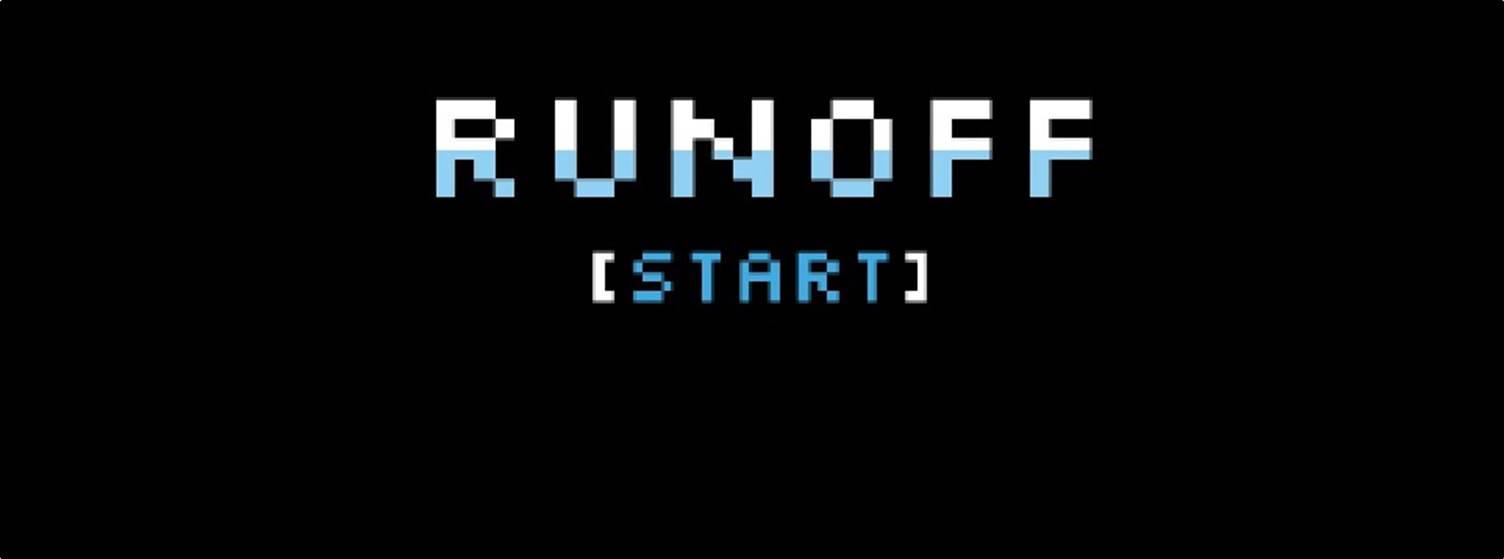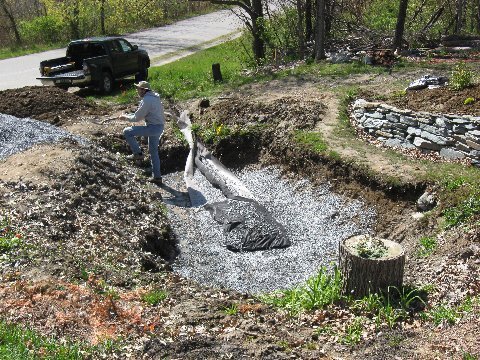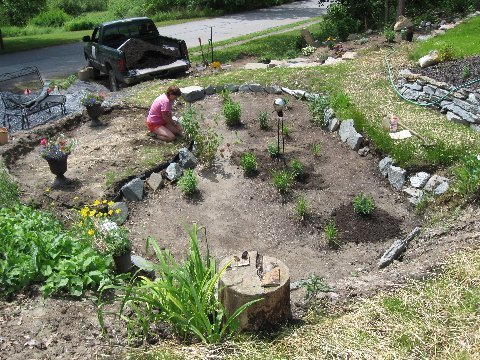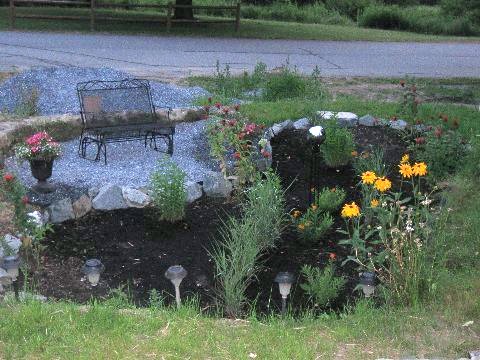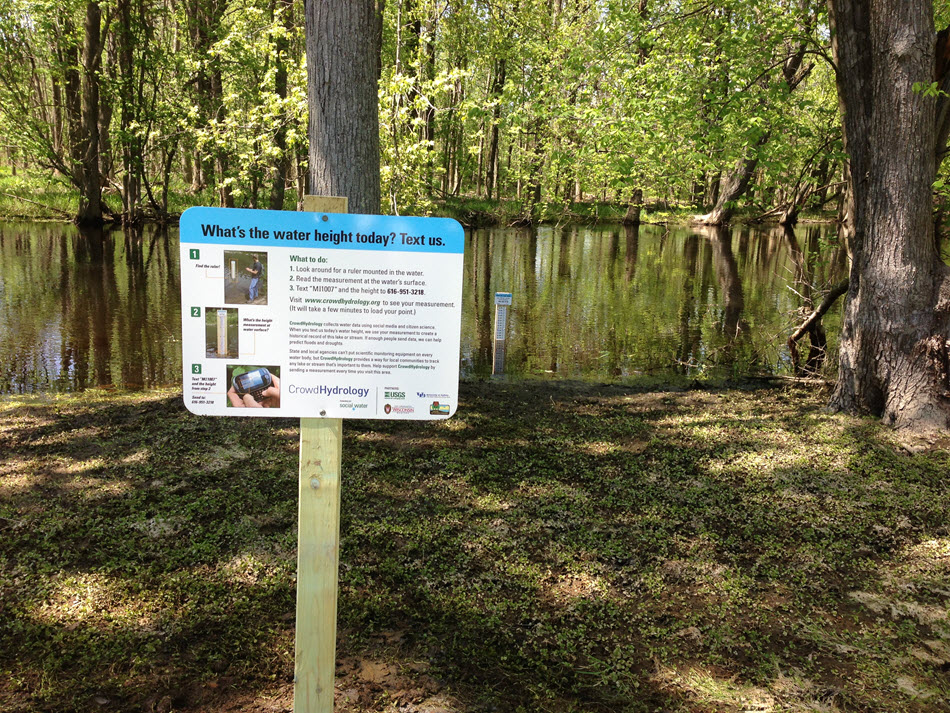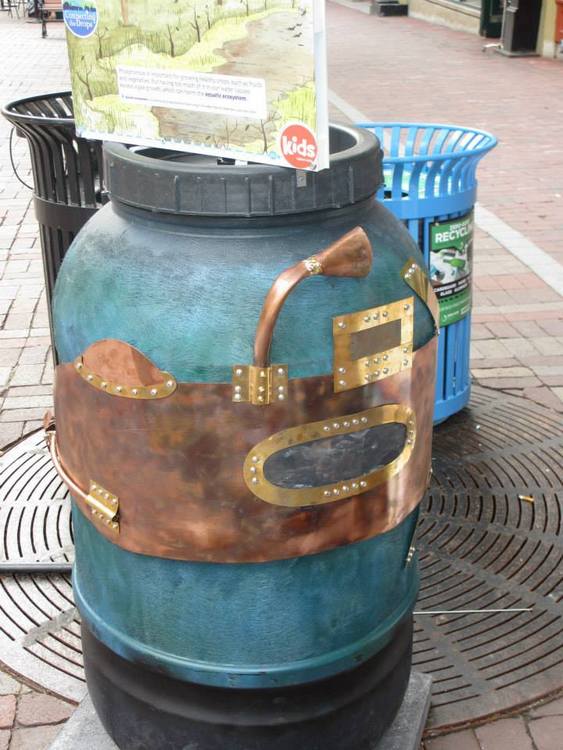
One of 19 rain barrels on display for Connecting the Drops, an outreach campaign on stormwater issues in the Lake Champlain Basin.
Image by Rebecca Tharp
In downtown Burlington, Vt., people stop to examine a blue rain barrel decorated with a metal submarine. It is one of 19 barrels transformed by local artists to tell the story of a raindrop and how it affects local water quality. The rain barrels line Burlington’s downtown thoroughfares leading to the edge of Lake Champlain. Each rain barrel contains a page of a children’s story about stormwater.
The barrels and the story lead participants to the ECHO Lake Aquarium and Science Center (ECHO). There, visitors can pour water through permeable pavement, take apart a rain barrel, learn about rain gardens, and play an interactive arcade-style game called Runoff.
Burlington’s unique combination of art and science is called Connecting the Drops, a public outreach campaign courtesy of the Let it Rain stormwater program.
Conveying the message
Terms like “runoff” and “nonpoint source pollution” are common in the stormwater professional’s vocabulary. But, conveying the meaning and implication of these words to the public takes creativity.
“The community is more aware when issues are apparent, and recent flooding events have helped significantly to ignite a local debate on stormwater management and flood resiliency,” said Rebecca Tharp, land-use planning and water quality educator at Lake Champlain Sea Grant. “The rain barrel is a symbol of water conservation that can be used to draw attention to stormwater issues. In this exhibit, we’ve used art to create a point of interest that can increase the accessibility of green stormwater infrastructure to the public.”
Connecting the Drops focuses attention on stormwater issues affecting Lake Champlain, particularly phosphorus loading. “Lake Champlain has been acutely affected by cyanobacteria blooms, which have caused many beach closures,” Tharp said.
Connecting the Drops also features weekly events with live music and displays by water groups, with games and prizes for attendees. “A static exhibit, like the rain barrels, benefits from community events to create energy, further engage with an audience, and give the exhibit some life,” Tharp said.
Providing a call to action
The campaign also highlights actions the public can take to manage stormwater through the region’s green infrastructure incentive program Let it Rain.
Started in 2012 by the Winooski Natural Resources Conservation District and Lake Champlain Sea Grant with funding from the State of Vermont’s Ecosystem Restoration Program, Let it Rain provides property owners in Vermont’s Lake Champlain Basin with technical and financial benefits for managing stormwater with green infrastructure.
Traffic on the Let it Rain website has increased fourfold since starting Connecting the Drops, Tharp said, and “applications and requests for site assessments have been steadily pouring in as a result of increased public awareness.”
Before the Let it Rain program began, “there was not a lot of crossover in Vermont on stormwater management programs and no consistency from year to year,” Tharp said. “Groups would get funding to do a project, and the next year, the funding would end.”
In getting the public to recognize and understand a message, longevity and consistency are important. In addition, putting together a successful public outreach campaign takes a significant amount of effort, which can be minimized by maintaining one program and coordinating among local partners.
Let it Rain provided a program around which regional partners could develop consistent messaging and language, as well as standard information, such as calculations to use when installing a rain garden. The program has already surpassed its goal of mitigating runoff from 2300 m2 (25,000 ft2) of impervious surfaces by July 1.
Involving the community
Involving the community is another way to increase awareness of and support for a program. Training local contractors, partnering with suppliers, and placing signage at green infrastructure facilities can improve dissemination of a message. Lake Champlain Sea Grant, a Let it Rain coordinator, has developed a Sustainable Landscapes Stewards training program, providing the community with green infrastructure experience and extending the breadth and capacity of its staff. This fall, the pilot stewards program will begin training skilled laypersons to conduct stormwater site assessments throughout the basin.
According to eMarketer, people trust the opinions of their peers 12 times more than company messages. A public outreach campaign cannot be successful without support from the community. Let it Rain helped community members share their success stories on the program website and through local media.
The story of Handy’s pervious parking lot
Gabriel Handy, general manager and president of Handy’s Hotels and Rentals LLC, watched as buckets of water poured by a University of Vermont student disappeared into pervious pavement. This was his first experience with the material, which led him to inquire about using it on his own 0.81-ha (2-ac) property.
“The pervious pavement was more costly than a pond,” Handy said. “But even with all the rain we’ve received this past month and a half, there has been no runoff. It has all been captured by the asphalt. The lot was well designed and well worth the extra expenditure.”
Originally considering a pond, Handy did not want to “create a mosquito heaven.” Watershed Consulting Associates designed the pervious lot and recommended applying for the Let it Rain rebate. Handy received a $5000 rebate, which covered about 3% to 4% of total project costs.
The story of the Carusos’ rain garden
Williston residents Ron and Maureen Caruso were planning to install a pond to improve drainage around the perimeter of their house but were concerned about mosquitoes. “We had heard good things about rain gardens, like that they clean up runoff that eventually goes into the brook,” Ron Caruso said. After researching the topic, he decided to install a rain garden on his property about a year ago.
“Building a rain garden was easy enough,” Caruso said. “The hole was already half-dug, because the land slumped down there. The hardest part was digging the mud out.” According to Caruso, the garden is efficient and was relatively inexpensive. In addition, Tharp connected them with the Let it Rain program, which awarded the Carusos a $250 rebate.
.
Making the message resonate
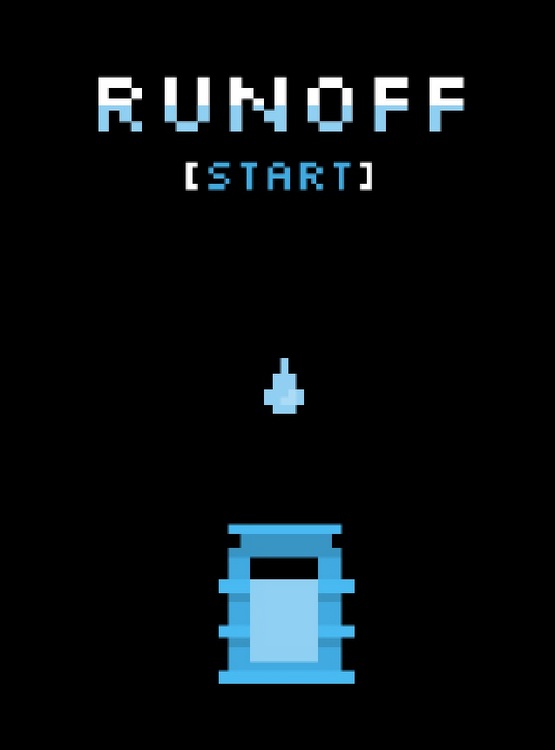
Runoff can be played as a mobile application or arcade-style at the ECHO Lake Aquarium and Science Center.
Tharp developed the stormwater storywalk concept and wrote an outline of important features. Kids VT, the state’s free monthly parenting magazine, edited and produced the 19-panel story, and Winooski artist Matt Morris illustrated.
“Stormwater runoff is kind of a ‘snoozer’ to the average person,” said Cathy Resmer, co-publisher and executive editor of Kids VT and associate publisher of the weekly newspaper Seven Days. “Our company is in the business of telling stories, and we saw an opportunity to make the story of stormwater runoff more engaging.”
One way of making stormwater more engaging was to create an interactive game. The rain barrel is at the heart of this project, so it only makes sense that it is the focus of the game Runoff, a project of Seven Days and Kids VT. In the classic 8-bit game, players must capture raindrops while avoiding objects, such as falling cats. When the barrel is full, players dump the barrel into a rain garden on either side of the screen, rather than down the storm drain.
“Runoff itself is a great visual — trying to catch water falling from the sky before it goes into the storm drain was instantly appealing,” Resmer said. Game developers at Birnam Wood Games, a studio run by recent graduates of Champlain College, helped Seven Days staff transform their ideas into a catchy arcade game and mobile application.
Seven Days will donate a quarter to Let It Rain for each of the first 1000 people who play Runoff at the ECHO Lake Aquarium and Science Center, helping to fund rain barrels for the Lake Champlain Basin.
“This was a great opportunity to use our skills to inspire individual actions that improve water quality in the Lake Champlain Basin,” Resmer said. The problem is especially tricky because it relies on people to change their behavior. Resmer’s son served as a game tester; when she asked him why he was catching rain in the barrel, he replied, “To save the fish.”
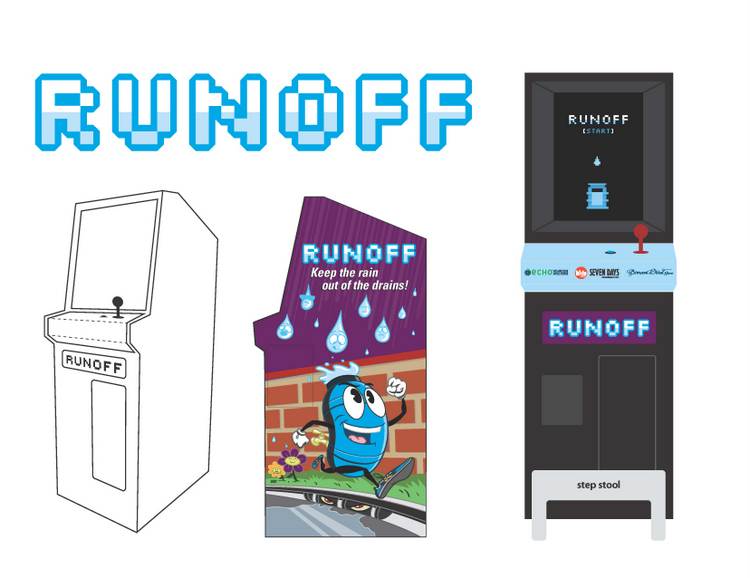
Logic Supply and Subatomic Digital provided and outfitted the Runoff game cabinet. Matt Douglas drew the character on the side of the cabinet, and ECHO Lake Aquarium and Science Center wrote copy for various educational screens.
Developing partnerships
Creative funding and a rich set of partners helped create the many facets of Connecting the Drops. In addition to the campaign’s media partners, Seven Days and Kids VT, ArtsRiot — a local art and culture promotional organization — coordinated the street fair events, and local artists adorned the rain barrels. “Support and partnership from Frog Hollow, the state’s art and craft center, provided a strong connection to working artists across the state,” Tharp said.
Financial support came from local Chittenden County groups the ECOS Project and Smart Waterways. In addition, Connecting the Drops received support in the form of staff time, materials, and planning from the City of Burlington, as well as Church Street Marketplace, the open-air mall where the rain barrels are located.
____________________
The rain barrel installation started in mid-May and will be available to the public until August. In early September, the rain barrels will be auctioned to help continue funding for the Let it Rain program. Area residents can also win a rain barrel by registering on the Let it Rain website. QR codes found on each of the 19 barrels also direct visitors to the registration page.
Sorry, there are no polls available at the moment.
